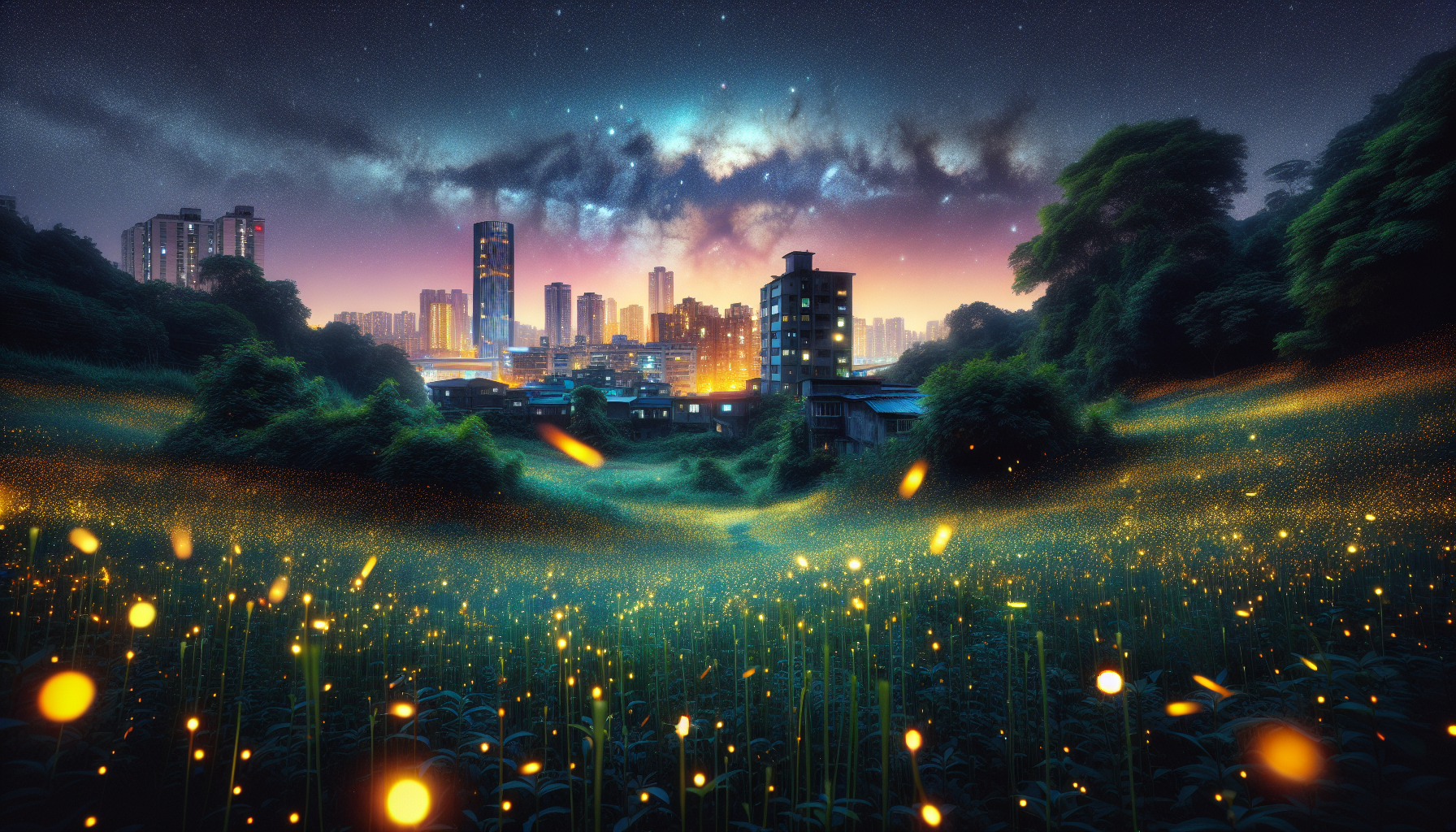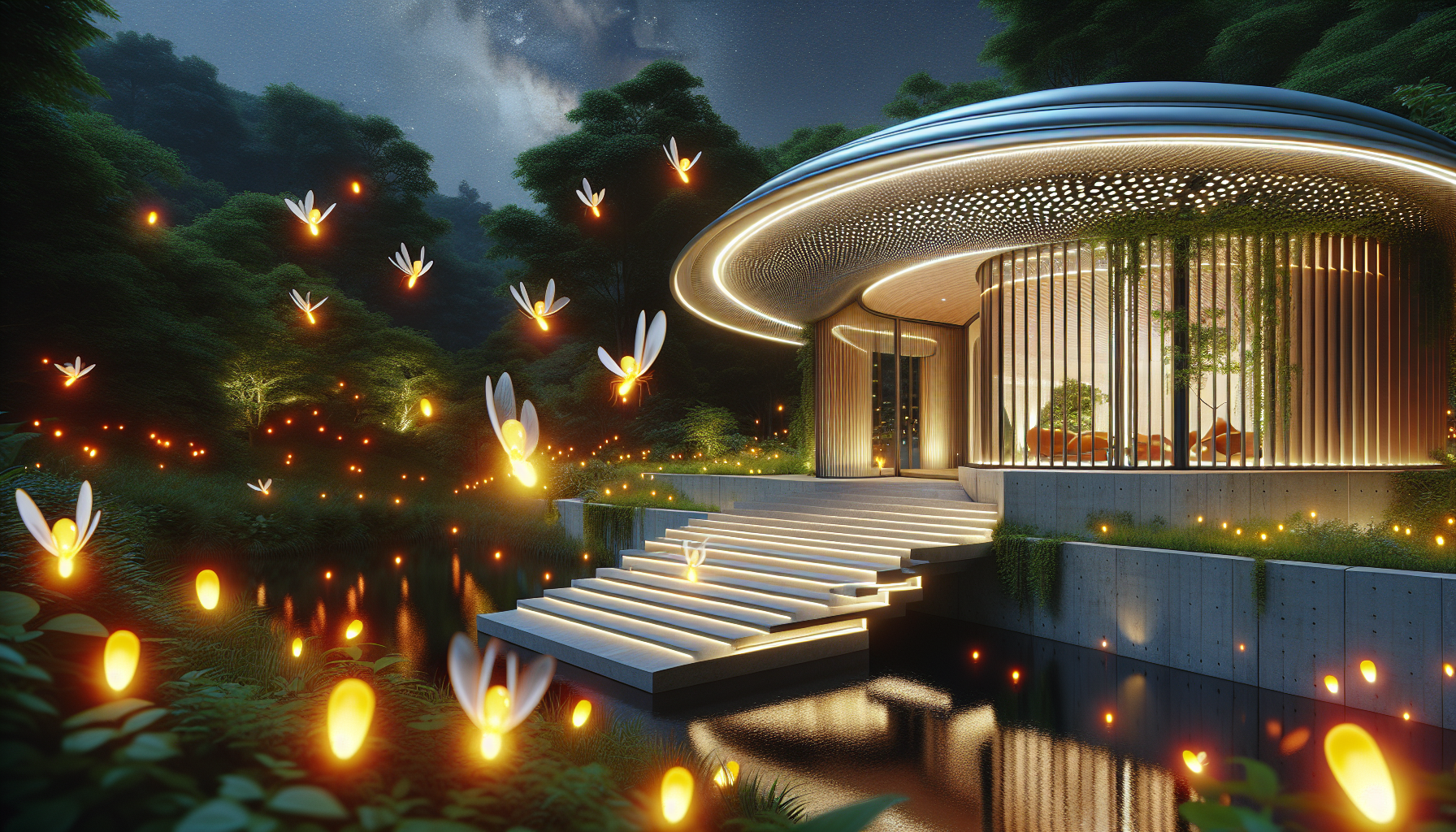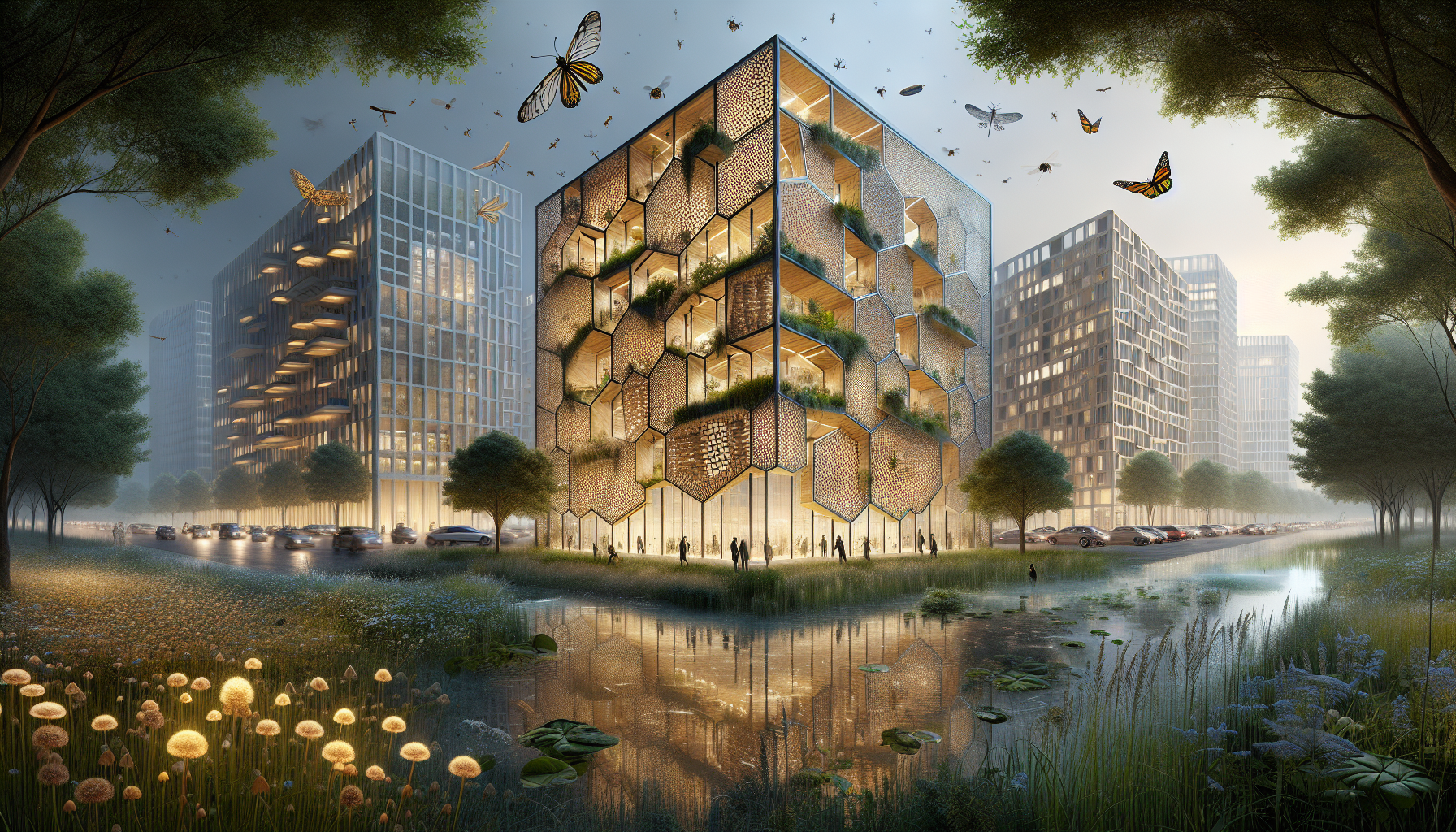In a world where artificial lights have become an omnipresent part of our daily lives, the ethereal glow of fireflies remains one of nature’s most enchanting spectacles. These small bioluminescent wonders captivate our imagination as they dance through the night, illuminating both urban and rural landscapes with their mesmerizing display. Yet, beneath their simple beauty lies a complex and fascinating science that governs their glow—a science that not only reveals intricate microstructures within their bodies but also highlights the delicate interplay between these creatures and their environments.
Fireflies, or lightning bugs as they are often affectionately called, have long been subjects of fascination for scientists and nature enthusiasts alike. The soft flicker of their light is not just for show; it serves a critical purpose in communication and mating rituals. However, what exactly enables these insects to produce such a captivating light show? The answer lies in the microscopic structures within their lanterns, which manipulate light in ways that are still being uncovered by science. From the arrangement of tiny scales to the role of specialized cells, each element contributes to the firefly’s ability to produce and control its light output.
As we delve deeper into this topic, we will explore the unique adaptations that allow fireflies to thrive in both urban and rural environments. Urban landscapes, with their abundant artificial lighting, pose challenges to these delicate creatures. The intrusion of man-made lights can disrupt the fireflies’ natural rhythms, affecting their mating success and population numbers. Conversely, rural settings provide a darker, more suitable backdrop for their luminous displays. This article will examine how fireflies navigate these differing environments, adapting their behaviors and bioluminescent signals to ensure survival.
Furthermore, we will uncover the latest scientific advancements that have emerged from studying these luminous insects. Researchers are continually discovering new aspects of firefly biology, including the biochemical pathways that enable light production and the genetic variations that account for differences in glow patterns among species. By understanding these mechanisms, scientists are not only advancing the field of entomology but are also applying this knowledge to innovative technologies, such as developing more efficient bio-inspired lighting systems and medical imaging techniques.
Join us on this illuminating journey into the world of fireflies, where science and fantasy converge. We will traverse through the microcosm of these captivating creatures, unveiling the secrets of their luminescence and exploring the broader implications of their existence. Whether you are an avid entomologist, a lover of nature, or simply someone who finds joy in the glow of a summer evening, this exploration promises to enlighten and inspire, shedding light on one of nature’s most magical phenomena. 🌟
Introduction to Firefly Fantasy
Fireflies have always fascinated both scientists and laypeople with their enchanting glow that illuminates dark summer nights. These luminous insects are not only a symbol of beauty and mystery but also a subject of intricate scientific inquiry. Firefly Fantasy explores the microstructures within these insects that allow them to light up urban and rural landscapes in unique ways. This exploration not only enhances our understanding of fireflies but also contributes to the field of biomimicry, offering potential innovations in technology and design.
The bioluminescence of fireflies, a phenomenon where light is produced and emitted by a living organism, is a captivating process governed by specific biological and chemical mechanisms. The process involves luciferin, an organic compound, and luciferase, an enzyme. When oxygen is introduced to this combination, a chemical reaction takes place, producing light. What is particularly interesting is the efficiency of this reaction; nearly 100% of the energy is converted into light, with minimal heat loss, making it a highly efficient light source.
Urban and rural landscapes present different challenges and opportunities for fireflies. In urban areas, light pollution poses a significant threat to firefly populations, disrupting their mating rituals and diminishing their natural habitats. Conversely, rural areas provide a more conducive environment for these insects, with less artificial lighting and more natural spaces. This article will delve into the specific microstructures that allow fireflies to adapt and thrive in these varying environments, providing a comprehensive understanding of their biology and ecology.
The Science Behind Firefly Bioluminescence
To truly appreciate the wonder of fireflies, one must delve into the science behind their bioluminescence. This natural phenomenon is a result of a complex interaction between chemical compounds and enzymes within the firefly’s abdomen. At the core of this process is the molecule luciferin. When luciferin is oxidized in the presence of the enzyme luciferase, adenosine triphosphate (ATP), and magnesium ions, it produces a light emission. This reaction occurs in specialized cells called photocytes, located in the light organs of the firefly.
The structural complexity of firefly lanterns, which house these photocytes, plays a significant role in maximizing light emission. Studies have shown that the lanterns’ microstructures enhance the efficiency of light production. For instance, researchers have identified the presence of nanoscale structures that act like a biological reflector, directing the light outward and reducing internal scattering. This intricate arrangement ensures that the light is emitted efficiently and visible from a distance, aiding in communication and mating.
One fascinating aspect of firefly bioluminescence is its adaptability to different environmental contexts. In urban settings, where artificial light can interfere with natural light signals, some firefly species have developed variations in their flashing patterns to compensate. This adaptability is a testament to the evolutionary pressures fireflies face and their resilience in maintaining their ecological niche.
Comparative Analysis of Urban and Rural Firefly Populations
Understanding the differences between urban and rural firefly populations is essential for conservation efforts and ecological studies. Urbanization has significantly impacted firefly habitats, often leading to population declines due to habitat fragmentation and light pollution. In contrast, rural environments generally offer more suitable conditions for firefly survival, with expansive natural habitats and reduced light interference.
| Feature | Urban Fireflies | Rural Fireflies |
|---|---|---|
| Light Pollution | High | Low |
| Habitat Fragmentation | Significant | Minimal |
| Flashing Patterns | Adaptive Variations | Consistent |
| Population Density | Lower | Higher |
As highlighted in the table, urban fireflies face challenges that require adaptations to their flashing patterns. In contrast, rural fireflies benefit from more stable environments that allow them to maintain their natural behaviors. This comparative analysis underscores the need for targeted conservation strategies that address the unique challenges faced by firefly populations in different settings.
Microstructures: The Key to Firefly Luminescence
The microstructures within fireflies are a testament to nature’s ingenuity in optimizing light production and emission. At the microscopic level, the surface of a firefly’s lantern is not smooth but rather textured with nanoscale structures. These structures serve multiple purposes, including enhancing light emission, improving the insect’s visibility, and reducing light absorption.
Recent studies utilizing advanced imaging techniques, such as scanning electron microscopy, have revealed the presence of intricate lattice-like patterns on the lantern’s surface. These patterns increase the surface area, allowing for more efficient light reflection and emission. Furthermore, the microstructures reduce the refractive index contrast between the lantern surface and the air, minimizing light loss and maximizing visibility. This optimization of light emission is crucial for firefly communication, especially in environments with varying light conditions.
In addition to enhancing light emission, these microstructures also play a role in protecting the firefly’s light organs. The physical design of the lantern provides structural support, ensuring that the delicate photocytes remain intact even in challenging environmental conditions. This combination of functionality and protection highlights the evolutionary success of fireflies and their remarkable adaptation to diverse ecological niches.
Applications of Firefly Microstructures in Technology
The study of firefly microstructures has profound implications beyond understanding insect biology. These natural designs have inspired innovations in technology and materials science. For instance, researchers are exploring ways to mimic firefly lanterns to create more efficient LED lights, which could revolutionize the lighting industry by reducing energy consumption and improving light quality.
Another exciting application is in the field of medical imaging. The principles of bioluminescence, combined with the microstructural insights gained from fireflies, are being adapted to develop non-invasive imaging techniques that enhance visibility and accuracy. This approach could lead to significant advancements in medical diagnostics, providing clearer images with less exposure to harmful radiation.
For a deeper understanding of these applications, watch the video below from the “Science Channel” on YouTube, titled “Biomimicry: Nature’s Design Inspiring Technology.” It provides a visual exploration of how scientists are drawing inspiration from nature to innovate across various industries.
The potential for biomimicry, inspired by firefly microstructures, is vast and only beginning to be tapped. As researchers continue to unravel the complexities of these natural designs, we can expect further breakthroughs that harness the efficiency and functionality observed in these fascinating insects. Whether in sustainable energy solutions or advanced medical technologies, the lessons learned from fireflies offer promising pathways for innovation.

Conclusion
In conclusion, the exploration of the “Firefly Fantasy: Unveiling the Intricate Microstructures that Light Up Urban and Rural Landscapes for Specific Insects” presents a captivating intersection of biology, urban planning, and environmental science. This comprehensive investigation has illuminated the complex ways in which fireflies and other light-dependent insects interact with their habitats, both in bustling urban centers and serene rural settings. Through a detailed examination of these microstructures, we have gained a profound understanding of how artificial lighting, pollution, and habitat modification affect these luminescent creatures.
One of the principal points highlighted in our exploration is the intricate biology of fireflies. These insects utilize bioluminescence not only for mating rituals but also as a defense mechanism. The specific wavelengths of light they produce are finely tuned to communicate effectively in their respective environments. In urban areas, where artificial lighting is prevalent, fireflies often face challenges in maintaining these crucial behaviors, leading to a decline in populations. Conversely, rural landscapes offer a more conducive environment for their natural light displays, allowing for a thriving ecosystem. This dynamic underscores the delicate balance between natural and anthropogenic factors in shaping the lives of these insects.
Moreover, the research has shed light on the broader implications of light pollution. Artificial lights disrupt not only firefly behavior but also have a cascading effect on entire ecosystems. By understanding the specific needs and behaviors of light-dependent insects, we can begin to develop strategies to mitigate the adverse effects of urban lighting. This involves not just reducing light pollution but also implementing thoughtful urban planning that considers the needs of these small but significant creatures. The integration of green spaces, the use of low-intensity lighting, and the preservation of natural habitats are all critical measures in creating a harmonious coexistence between human development and insect life.
The significance of this research cannot be overstated. Fireflies and similar insects play vital roles in their ecosystems, serving as pollinators, prey, and indicators of environmental health. Their presence or absence can reflect the broader health of an ecosystem, making them essential in environmental monitoring and conservation efforts. By prioritizing the study and preservation of these luminous insects, we contribute to the broader goal of biodiversity conservation, which is crucial for maintaining ecological balance and resilience in the face of changing global conditions.
As we reflect on the findings of this research, it is crucial to recognize the responsibility each of us bears in protecting these fascinating creatures. Simple actions, such as reducing outdoor lighting, supporting local conservation efforts, and spreading awareness about the importance of fireflies, can make a significant difference. In doing so, we not only safeguard the delicate beauty of these insects but also foster a deeper connection with the natural world.
We encourage readers to share this knowledge within their communities, sparking conversations about the importance of sustainable practices that benefit both humans and the environment. By engaging in discussions and spreading awareness, you can play a pivotal role in advocating for the preservation of fireflies and their habitats. Together, we can work towards a future where urban and rural landscapes are designed with biodiversity in mind, ensuring that fireflies continue to grace our nights with their enchanting glow.
Inspiration can be drawn from ongoing research and initiatives worldwide. For further reading and engagement, we recommend exploring resources from reputable organizations such as the International Dark-Sky Association (IDA) www.darksky.org and the Xerces Society for Invertebrate Conservation www.xerces.org. These platforms offer valuable insights and actionable steps for contributing to conservation efforts.
In closing, let us be inspired by the beauty and complexity of fireflies and other light-dependent insects. Their luminous presence reminds us of the intricate web of life that connects all living beings. By protecting these small but significant creatures, we are safeguarding a vital piece of our planet’s biodiversity. Let us move forward with a renewed commitment to environmental stewardship, ensuring that future generations can marvel at the magical dance of fireflies in both urban and rural landscapes. 🌟
Toni Santos is a visionary artisan and conceptual designer who channels the beauty of living organisms into structural expression. At Zureste, Toni explores the intricate elegance of insect anatomy, organic flow, and bioinspired design to create art that feels both natural and otherworldly.
Each creation Toni brings to life reflects a harmonic tension between structure and softness, wildness and control — echoing the complex intelligence found in the natural world. From beetle-like silhouettes to root-shaped contours, his work blurs the lines between biology, sculpture, and modern art.
Guided by fascination for metamorphosis, evolution, and pattern in nature, Toni’s pieces embody transformation. His BioLight Collection and conceptual series like Insect Type and Structure Aesthetics offer viewers more than aesthetic value — they present immersive experiences of living design.
As the creative force behind Zureste, Toni invites us to rethink beauty, architecture, and identity through a new lens — one shaped by wings, bones, spirals, and the microscopic poetry of the organic.
🌿 His creations reflect:
-
Design deeply rooted in the geometry of life
-
Inspiration from insects, roots, and the unseen natural order
-
A blend of science, spirituality, and visual storytelling
Whether you’re a lover of strange beauty, an admirer of evolution’s artistry, or a creative mind seeking something different, Toni welcomes you into a world where living forms become meaning, and surreal becomes sublime.




